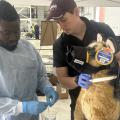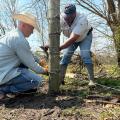Wildlife Flooding Information
As flood waters rise in wildlife habitat areas, animals may seek shelter in locations where humans live or may become isolated on “islands” where they have no access to food. While it is human nature to want to help these wild animals, the following provides answers to frequently asked questions regarding supplemental feeding, human safety issues, possible human-wildlife conflicts, and precautions around wildlife.
SUPPLEMENTAL WILDLIFE FEEDING
Question: Should I feed wildlife in my backyard or property?
Answer: In most cases no. The best course of action is to leave wildlife alone while they move through your property searching for available habitat on higher ground. Feeding will offer an incentive for deer and other wildlife to remain on your property, rather than moving along.
Question: What if deer are stranded on a levee or man-made structure with no access to food?
Answer: Although this answer may be unsettling to most people, in a majority of situations, it is best to leave deer alone and let nature take its course. Most people have the best intentions, feeding isolated or stranded deer (or other wildlife may do more harm than good). However, approaching these isolated areas may cause deer to jump in the water, putting them at greater risk. Furthermore, feeding these animals will prompt congregation of animals which may promote disease transmission.
Question: If the situation were appropriate, what should we feed stranded deer?
Answer:
A pelleted full-ration feed of at least 12 percent crude protein placed in a trough-type feeder is the best feeding option for deer. Cattle or dairy feed is acceptable and is typically cheaper than deer feed. Feed should be kept off of the ground to minimize spoilage and contamination (e.g., excrement from deer and other wildlife). Range pellets or cubes are an option if they are spread across an area to avoid animal concentration.
Hay – Fescue, Bahia, Bermuda hays (and other hays from grasses) are not recommended for deer because the nutritional content is not adequate for deer (it will cost deer more energy to digest this type of hay than the deer will gain from it). Alfalfa or peanut hay is more suitable for deer, although these types of hay are generally more expensive and less available.
Corn can be used, (it is illegal to feed corn to deer before July 1, 2011 http://www.mdwfp.com/Level2/Wildlife/pdf/final/2008/W-3796.pdf), but there are potential dangers with aflatoxins (which may increase if the corn is on the ground and exposed to moisture). Deer can sustain high levels of aflatoxins, but birds (e.g., wild turkey) are susceptible and more likely to die from aflatoxin poisoning. Also, too much corn (or other grains like oats, wheat, etc.) can be harmful to deer. If deer have access to some natural forage, or pelleted deer feed, the problem should be minimal, but a diet composed primarily of corn or other grains can lead to rumen acidosis and cause long-term damage and death to the deer.
POTENTIAL FOR ANIMAL DEATH
Question: Will animals die from the flood?
Answer: Yes, some animals will die. Currently, there is no way to estimate the rate of mortality that will occur and it will likely vary from location to location depending on flood conditions. The young and really old animals will be most vulnerable. Remember that most of these animals are adapted to flooding situations, and many will survive. The amount of wildlife mortality will depend on the spatial extent and duration of the flood.
Question: Can we use this opportunity to dispatch feral hogs?
Answer: Yes, this may be a great opportunity to dispatch feral hogs as they are a highly invasive, nuisance animal. As long as you are on private property, or you have permission from the landowner, you may harvest feral hogs. Please use caution and make certain of your target! Don’t make the mistake of shooting other wildlife (like black bear). For more information regarding the legalities of shooting feral hogs, please visit http://home.mdwfp.com/wildlife/Species/Nuisance/info.aspx?id=772#hog
HUMAN-WILDLIFE CONFLICTS
Question: Why are deer crowding in residential areas and on people’s property?
Answer: Flood waters have destroyed much of the vegetation that deer need for food and cover. High waters also push deer out of the low-lying bottomlands into upland, sometimes residential areas. Although deer and other animals would not prefer to inhabit locations with high human populations, they are merely attempting to seek refuge. Unfortunately, high concentrations of deer in residential areas greatly increase the potential for human-wildlife contact and may lead to deer in backyards, gardens, and roads. Please use caution when driving if large groups of deer have been reported or seen. Deer vehicle collisions can cause extensive damage to cars, and injury to humans.
Question: What if a wildlife animal is near or in my residence?
Answer: Although unlikely, a large wildlife species such as a deer may run inside a house or building. This situation can be dangerous as the animal is likely under duress and may be combative. To avoid injury, put as much space as possible between you and the deer, open as many exit points as possible (windows, doors) and wait for the animal to exit on its own. If the animal persists and appears aggressive or injured, the authorities may need to be contacted. In the case of a small animal, a broom or stick may work to escort it from the building. Never directly approach any animal inside a building or attempt to restrain and handle wildlife.
Question: Are there any potentially dangerous animals to watch out for? What should be done to avoid any contact with these animals?
Answer: In natural disaster situations such as flooding where all ecosystems are disrupted, there is an increased likelihood of potentially dangerous animals to come in contact with humans:
Alligators could appear in roadways or yards. Most alligators are normally non-aggressive unless provoked. As a precaution, stay very far away from the animal and keep pets on leashes. If human life is in danger, contact the authorities immediately.
Snakes seek temporary refuge in homes and buildings during natural disasters. Cottonmouths would be the most probable venomous snake you might encounter. Be watchful while moving through high waters or clearing debris. Check attics, cupboards, outbuildings, and ventilation for snake presence. Wear long pants, boots, and gloves when walking through standing water.
Bear encounters will rarely occur but if a bear wanders into a residential area, keep all people and pets at a safe distance. The Louisiana Black Bear is a federally protected animal and the American Black Bear is protected in Mississippi. Bear encounters may warrant a call to conservation officers or the local authorities, particularly if human safety is at risk.
Fire Ants are flushed from their nests in large surges of water or flood situations. Once flushed, they form a raft by attaching to one another and are able to float on top of water. These large concentrations of ants can be aggressive and cause serious bites.
Mosquito numbers are likely to explode with flood waters left behind in all types of containers such as old tires, boats, and even swimming pools. Mosquitoes can spread diseases such as encephalitis and West Nile Fever.
Question: Are there any safety issues with eating fish that have been caught in flood waters?
Answer: Fish pulled from flood waters may contain contaminates such as mercury or lead in its fat tissues. These heavy metals as well as pesticides from flooded fields can occur in high concentrations in these fish. Consumption of these fish should be avoided until the proper authorities have deemed the fish safe.
Question: What precautions can I take to ensure I do not get sick from flood waters?
Answer: Avoid handling animals without gloves, do not drink or eat anything that has come in contact with flood water and wash hands and/or bathe thoroughly if your skin comes in contact with floodwaters.
HABITAT ISSUES
Question: Are there any habitat damage concerns associated with animals displaced by floodwaters?
Answer: Due to flooding, there is less available habitat for animals to seek refuge. Less available habitat results in fewer available resources and greater competition (between and among species) as these areas exceed carrying capacity. The following are some potential concerns for wildlife and wildlife habitats:
As a result of greater competition, vegetation is eaten down closer to the ground and animals are forced to feed closer to the soil. Potential problems:
Greater damage to native plant communities – prolonged damage may result in some communities not being able to recover.
Greater chances of disease transmission and internal parasite infections in wildlife (between and among species).
As animals are pushed further away from the river and from overcrowded habitats, expect to see greater amounts of wildlife damage to croplands not affected by floodwaters.
SMALL MAMMAL AND DISEASE ISSUES
Question: Should I be concerned about mice, rats, and other small mammals nesting in my residence or spreading disease?
Answer: Potential exists for small mammal species to invade more homes, barns, grain bins, and other storage facilities.
Disease Risks:
There are a couple of strains of Hanta virus transmitted by rodents in the Southeast – Cotton Rats and White-footed Mice. Transmission to humans is from handling animals without gloves and breathing in aerosolized urine and feces particles. It’s low risk, but the potential exists in areas with high rodent populations.
A number of small mammals and meso mammals serve as reservoirs for tick transmitted illnesses (STARI, Ehrlichia).
Giardia – Beaver, nutria, muskrat
Leptospirosis – Most small and meso mammal species
Swimmer’s itch – Most small and meso mammal species and ducks
PUBLIC LAND ACCESS
Panther Swamp National Wildlife Refuge (east of the Whittington Auxiliary Channel) is experiencing significant flooding due to record breaking stages on the Mississippi River. Ground elevations throughout this portion of the Refuge rarely exceed 100 ft (above mean sea level). Based on current projections by the U.S. Army Corp of Engineers, floodwaters could reach 107 ft. At this level, approximately 20,000 acres would be completely inundated. At this level of flooding many species of wildlife will be seeking areas of refuge from rising waters. These areas will mostly consist of levees and roadways. Given this, Panther Swamp NWR has been closed for public use to provide sanctuary areas for displaced wildlife. Both the East and West Levees of the Whittington Auxiliary Channel have been closed to traffic other than law enforcement and refuge personnel.
Publications
News
FLOWOOD, Miss. -- When responding to emergencies, collaboration between state agencies is critical in the effort to save lives.
EGYPT, Miss. -- On hot days, Robert Thompson’s beef cows used to retreat to a cluster of trees in the middle of his pasture for shade.
STARKVILLE, Miss. -- After natural disasters, food and shelter are prioritized well above mental health, but ignoring emotional distress can lead to serious physical health conditions.










